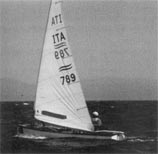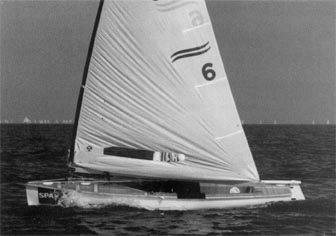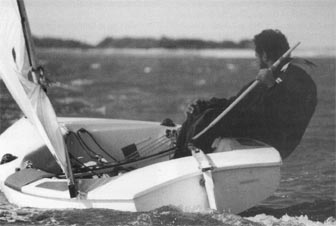| 16. John Bertrand on Boat Speed |
by John Bertrand |
|
We have discovered on the Finn that outhaul tension is critical to pointing ability. I first observed it when my friend Thomas Jungblut and I were testing some new Finn sails in Milwaukee.
|
As with all momentous discoveries we came across it purely by accident. After developing a sail which proved to be very good in winds above 15 mph we were about to give up hoping it would succeed in being versatile, and therefore fast in the 8-15 mph range.
Sailing back to harbour after a solid day of sail testing with another boat, my outhaul came untied and the sail slipped in about 5". We did a final test on the wind and discovered that the sail which had previously lacked speed and pointing ability through the chop had excellent characteristics. The rig literally came alive and for the first time this fast heavy air sail was able to hang in there in the light winds and choppy water. |
 |
|
We subsequently took photographs of the resulting sail shapes at different outhaul settings and then began to appreciate how significant an outhaul can be. By easing the outhaul, the sail particularly in the bottom half, increases in depth in a circular fashion up to 50 % The whole secret was to start off with a sail relatively flat in the bottom, i.e. a heavy wind type sail and progressively ease in when more power was required. Easing the outhaul on an already full sail will make the sail over full, set up too much drag and the result is slow. |
So we essentially discovered that by starting off with a heavy air type sail, by playing with the outhaul we were able to be very competitive in the medium air. This was significant because it seems impossible to go the other way and make a good medium air sail highly competitive in fresh winds. We then increased the foot mound to such an extent that we essentially had a loose footed sail except we retained the end plate effect.
Gus Miller, the then 42 year old Finn sailor from Ann Arbor/Michigan took it one step further and started to have a good hard look at the other sail shape controls on the Finn rig. He discovered that the inhaul was also a critical adjustment as well, although not so obvious at first. By designing the tack with a cut away of about 3 inches and having a control line attached to the tack leading forward to the gooseneck and back to the side tank, the position of the tack could be easily adjusted.
|
 |
|
 |
wind |
smooth water |
rough water |
| Beaufort |
outhaul |
inhaul |
Cunningham |
outhaul |
inhaul |
Cunningham |
| 0-1 |
5.0 cm |
off |
off |
7.5 cm |
off |
off |
| 1-2 |
5.0 cm |
off |
off |
10.0 cm |
neutral |
neutral |
| 2 |
7.5 cm |
neutral |
off |
12.5 cm |
neutral |
neutral |
| 3-4 |
5.0 cm |
neutral |
neutral |
12.5 cm |
on |
neutral |
| 4-5 |
2.5 cm |
neutral |
on |
5.0 cm |
on |
on |
| + 5 |
0 |
on |
on |
2.5 cm |
on |
on |
|
Again it seems there is nothing new in sailing, it only remains for us to discover them over again and indeed the great Paul Elvstrom had cut away tacks back in the late 50's. But unfortunately he didn't tell me or Gus anything about them, so it was up to Gus to lead the way. Anyway Gus found that by pulling the tack towards the mast the bottom batten angle in particular was changed. We call this the lower exhaust angle of the sail and if we know one thing, the lower batten angle really has a large effect on weather helm. Have the bottom batten closed and the rig develops helm, open the batten and the helm goes neutral. So when Gus wanted more weather helm to point he would immediately ease off the tack inhaul. If he wanted more speed or had trouble steering he would pull the tack closer to the mast to neutralise his helm.
|
 |
|
He then had a good hard look at what the Cunningham did. Any book will tell you that increased Cunningham tension will move the draft forward in the sail and open the leech. We found, however, that it has a huge effect particularly in the upper half. That is, Cunningham tension opened up the upper batten area but did not alter very significantly the lower batten angle.
Because the upper part of the leech is relatively close to the pivot axis of the boat, the exhaust angle of the leech does not change the helm all that much. However it has a huge influence on heeling moment, so when Gus' legs would give out (he is 42 you know) he would pull down on his Cunningham which would free the upper leech, and therefore reduce heeling moment. If he then had pointing problems, he would ease the tack out away from the mast to close the lower battens and inject more weather helm into the boat. Let me say Gus was fast and it was obvious he was onto something. A couple of Finn parties later, I had all the information I needed. Gus was never one for keeping secrets anyway. |
Summary
Outhaul: changes curvature particularly in lower half. For smooth water, the lower camber can be on the flat side, but in rough water more curvature is required, therefore the outhaul is eased in. The outhaul adjustment was used just as much as mainsheet tension and traveller on the Finn.
Inhaul: If pointing ability was lacking the tack is eased away from the mast. This closes the lower batten plus it makes the leading edge of the sail finer off the mast.
Cunningham: If heeling moment was no problem, very little Cunningham was used -just to clear up excess wrinkles off the mast. As soon as the boat became overpowered excessive Cunningham is used to open the upper leech.
|
 |
|